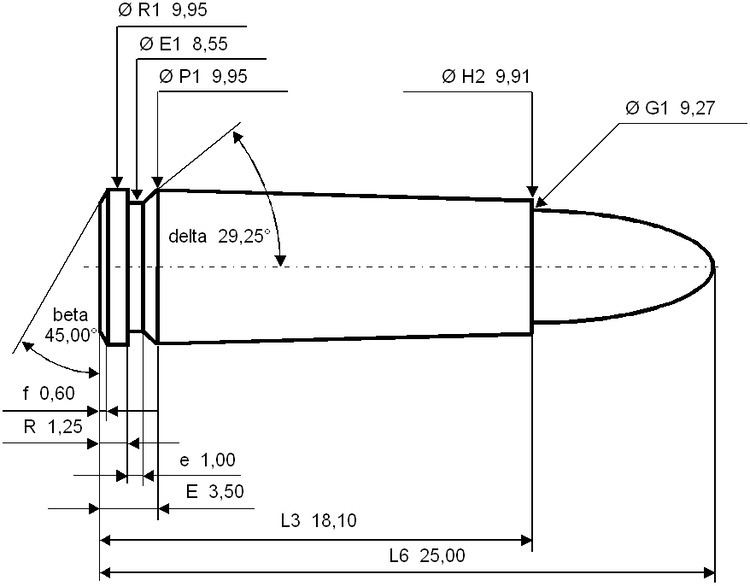Designer B.V. Semin Produced 1951–present | Designed 1946 | |
 | ||
Used by Russian Armed Forces,Polish Armed ForcesArmed Forces of Ukraine,Cuban Revolutionary Armed Forces,People's Army of Vietnam,Military of Bulgaria,People's Liberation Army,Military of the Czech Republic,Military of Slovakia, others | ||
The 9×18mm Makarov (designated 9mm Makarov by the C.I.P. and often called 9×18mm PM) is a Russian pistol and submachine gun cartridge. During the latter half of the 20th Century it was a standard military pistol cartridge of the Soviet Union and the Eastern Bloc, analogous to the 9×19mm Parabellum in NATO and Western military use.
Contents
History
During the Second World War and the early Cold War, the 7.62×25mm Tokarev was the standard automatic pistol round for the Soviet Union and its satellites in Eastern Europe. This ammunition is still in use by many of these countries today. During the war the Red Army had found a few shortcomings of its 7.62mm TT-33 pistol, one of which was a tendency to inadvertently drop its magazine while in operation. The army wanted something that was lighter, with a heel release instead of a button and different ammunition. A direct blowback design was chosen for the pistol's operation, since it would be quick and cheap to manufacture, as well as accurate, due to the fixed-barrel design allowed by direct blowback operation.
The 9×18mm Makarov round was designed by B.V. Semin in 1946, and was intended to be a relatively powerful round with modest bolt thrust that could function safely in a simple or direct blowback pistol. It was based on the 9×18mm Ultra cartridge which was developed in 1936 by Gustav Genschow & Co. for the German Luftwaffe, as a more powerful alternative to the 9×17mm used in the Walther PP, also a simple blowback design pistol. Nikolay Fyodorovich Makarov went on to design the Makarov PM pistol around the 9×18mm Makarov round in 1948.
The fact that the Soviet military required that their ammunition should be incompatible with NATO firearms is a myth, as caliber in the USSR is measured between the lands in the rifling and not the grooves. As such, 9×18mm Makarov ammunition uses a larger diameter bullet than other common 9 mm rounds, measuring 9.27 mm (0.365 in), compared with 9.017 mm (0.355 in) for 9×19mm Parabellum. After its introduction in 1951, the 9×18mm Makarov round spread throughout the militaries of Eastern Bloc nations.
Dimensions
The 9×18mm Makarov has 0.83 ml (12.8 grains H2O) cartridge case capacity.
9×18mm Makarov maximum C.I.P. cartridge dimensions. All sizes in millimeters (mm).
The common rifling twist rate for this cartridge is 1 in 240 mm (9.45 in), 4 grooves, ø lands = 9.00 mm, ø grooves = 9.27 mm, land width = 4.50 mm and the primer type is small pistol.
According to the official C.I.P. (Commission Internationale Permanente Pour L'Epreuve Des Armes A Feu Portatives) rulings the 9×18mm Makarov case can handle up to 160.00 MPa (23,206 psi) piezo pressure. In C.I.P. regulated countries every pistol cartridge combo has to be proofed at 130% of this maximum C.I.P. pressure to certify for sale to consumers.
The 9×18mm Makarov is ballistically inferior to the 9×19mm Parabellum cartridge. While there are no official SAAMI pressure specifications for the 9×18mm Makarov cartridge, tests indicate that surplus ammunition develop pressures in the mid 20,000 psi, significantly less than the 35,000 psi or more generated by 9×19mm Parabellum loads. As such it is designed to be used in low-powered blowback semiautomatics, much like the .380 ACP cartridge, rather than locked-breech designs encountered, but not always required, for higher pressure cartridges like the 9×19mm Parabellum.
Basic specifications of 21st century Russian service loads
The 9×18mm Makarov rounds in use with the Armed Forces of the Russian Federation are designed for pistols and submachine guns. In 2003, there are several variants of 9×18mm Makarov produced for various purposes. All use clad metal as case material.
The 57-N-181S cartridge is loaded with a steel-core bullet and is designed to kill personnel at a range of up to 50 m (55 yd). The bullet has a clad metal envelope totally covering the core. The bullet’s nose is spherical with no distinguishing color of the tip. It can penetrate a 1.3 mm thick St3 steel plate or 5 mm ordinary steel plate at 20 m (22 yd).
The RG028 cartridge is loaded with an enhanced penetration bullet and is designed to kill personnel wearing body armour. The bullet has a core of hardened steel.
The SP-7 cartridge is loaded with an enhanced stopping effect bullet and is designed to defeat live targets. The bullet has a black tip.
The SP-8 cartridge is loaded with a low-penetration bullet and is designed to engage personnel.
